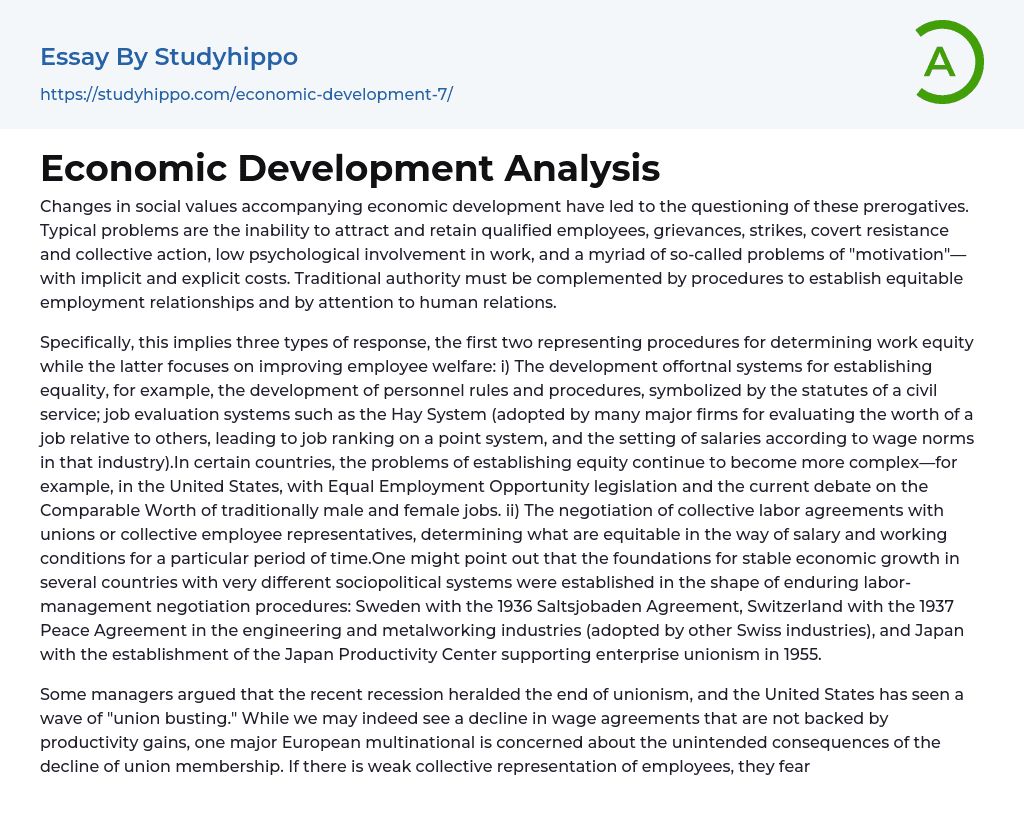Due to economic growth, social values have shifted, resulting in the challenge of established privileges. This often leads to issues such as difficulty in hiring and keeping skilled workers, complaints, walkouts, hidden forms of protest and group actions, decreased emotional investment in work, and many motivation-related barriers that come with both implicit and explicit costs. It is necessary to supplement traditional power structures with methods that foster fair employment arrangements and prioritize interpersonal relationships.
The text discusses three different responses regarding work equity, which include the development of formal systems to establish equality, such as personnel rules and procedures represented by civil service statutes, and job evaluation systems like the Hay System. These systems evaluate the value of a job in comparison to others, resulting in job rankings and salaries based on industry wage norms. Finally, improving employee welfare is also a s
...ignificant focus. However, the matter of establishing equity has become increasingly intricate in certain countries, such as the United States, due to Equal Employment Opportunity laws and discussions regarding jobs that are traditionally associated with men or women, known as Comparable Worth.The negotiation of labor agreements with unions or collective employee representatives is essential for determining fair salary and working conditions for a set period of time. Countries with varying sociopolitical systems have established stable economic growth by implementing long-lasting labor-management negotiation processes. Sweden's 1936 Saltsjobaden Agreement, Switzerland's 1937 Peace Agreement in the engineering and metalworking sectors (also adopted by other industries), and Japan's Japan Productivity Center, which supports enterprise unionism established in 1955, are examples of this.
Despite some managers' belief that the recent recession marked the end of unions and led to a
wave of "union busting" in the United States, a major European multinational is concerned about the unintended consequences of declining union membership. If there is weak collective representation of employees, they fear the administrative cost and turmoil of having to negotiate equity with numerous small groups of employees. Consequently, management is considering establishing Japanese-style enterprise unions to improve human relations, working life quality, and human resource policies - elements consistently found in successful non-unionized firms (Foulkes, 1980).
The development of humane authority that acknowledges the employee's integrity involves supervisory training in human relations and managerial/style. Meanwhile, improvements in quality of working life, employee welfare, semi-autonomous working arrangements, open door policies, and single status systems are bringing about the progressive humanization of the work place. How equity and human relations challenges are addressed within companies and countries differs greatly. Some firms recognized early on the importance of equity in human resource management, often due to the values of their founders or presidents (such as Marks ; Spencer and Procter ; Gamble). While companies' records vary in the free-market economy of the United States, some Northern European countries tackled internal challenges related to equity and human relations before or after World War II as a result of political events and legislation.
Since 1955, Japanese firms have placed great importance on achieving equity and better working conditions (Takezewa et al., 1982). Conversely, Latin Europe and Latin America have only recently begun to address these issues, with Brazil experiencing social unrest and unionization as it undergoes democratic liberalization. Unfortunately, many senior executives in Latin cultures still hold to a traditional view of authority, resulting in strained relations with labor.
When
evaluating human resource management, focusing solely on equity and internal relationships can create a bureaucracy, as referred to in both economic theory and common language (Evans, 1984). The other important criterion for HRM is competitive performance.
- Performance essays
- Human Resources essays
- Recruitment essays
- Code of Ethics essays
- Organizational Behavior essays
- Dress Code essays
- Safety essays
- Conflict essays
- Qualities essays
- Adaptation essays
- Adventure essays
- Adversity essays
- Aging essays
- Alcohol essays
- Barbie Doll essays
- Beauty essays
- Care essays
- Carpe diem essays
- Change essays
- Chess essays
- Chicken essays
- Choices essays
- Contrast essays
- Crops essays
- Development essays
- Dream essays
- Evil essays
- Experience essays
- Family essays
- Farm essays
- Fire essays
- First Love essays
- Focus essays
- Greed essays
- Hero essays
- Holiday essays
- House essays
- Housing essays
- Humility essays
- Humor essays
- Hypocrisy essays
- Integrity essays
- Law of Life essays
- Life Changing Experience essays
- Life Experience essays
- Lifestyle essays
- Limitations essays
- Love Story essays
- Mother Tongue essays
- Motherhood essays




